Going Digital
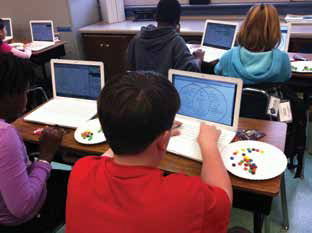
Maybe your teachers are asking for it. Maybe your superintendent has mentioned it. Or maybe your state is demanding it.
Regardless of where the concept originates, a lot of districts are “just saying no” to textbooks and creating a digital curriculum.
Not sure where to start? As always, we turn to our experts: the districts that are already on board with this new digital reality. Here are their insights.
Digital math is much more engaging—and tasty!—at Piedmont City Schools. As you move into a digital curriculum, how have you changed your educational and financial decision making processes?

Karen Fuller, chief technology officer, Klein (TX) ISD: Last year, we created a Long Range Technology Plan committee (LRTP) made up of my team leaders and a representative from each of the district departments. Together, we created our new tech plan. The LRTP committee meets every other week to review. When a new idea comes up, the Research and Development committee looks to see if it’s feasible, asks questions, and brings other people in that may be impacted by the idea. If that committee deems it’s something that we need to do, they bring it back to the LRTP. Then it goes to the Change committee, who ultimately determines if the district will implement. This process helps us to be a lot more cohesive when we roll out new products or initiatives. We’ve started really utilizing committee decision making instead of individual decision-making, which, to me, is a lot more efficient.
Bob Gold, superintendent, Eureka (IL) CUSD 140: The decision to move to the digital curriculum in 7th- and 8th-grade mathematics was primarily educational. For math, it just works very well. This model has provided our teachers with more one-on-one and small-group instruction time. Kids are receiving the help they need, when they need it. Financially, we chose to do this when we were looking at purchasing new math textbooks. I felt that our money would be better spent invested in the technology and the time for the teachers to develop the curriculum via open source.
7th- and 8th-grade students at Eureka CUSD 140 enjoy working on digital math lessons. Jim Klein, director of information services and technology, Saugus (CA) Union School District: As it stands now, the digital curriculum for most schools is about delivering hard materials, (i.e., digitizing content, which is pretty irrelevant, in my view), and we have not aggressively pursued it. Digital copies of analog textbooks are hardly transformational— even if they offer such ‘thrilling’ constructs as digital quizzes at the end of a chapter or the occasional manipulative. This will never lead to the sort of cultural changes we should be seeking. A more authentic approach would be to create an environment in which kids learn as we learn—by searching, sifting, vetting, reading, and analyzing the vast and ever-growing array of content online and by leveraging whatever social and educational connections they have, all under the wisdom and guidance of an experienced teacher. Our approach, therefore, is to provide the tools and training necessary for our teacher leaders to build their own guiding content and resources online (e.g., wikis and blogs), constructing authentic tasks that help our students learn how to learn. Unfortunately, we can’t get rid of textbooks here in California (required adoptions), and those, combined with standards that lead to standardized testing, make it difficult to break through the barriers of traditional education and expectations.
Tools and ideas to transform education. Sign up below.
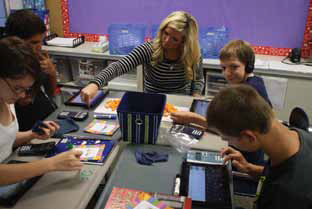
It’s time to blog for Saugus USD students. Scott S. Smith, chief technology officer, Mooresville (NC) Graded School District: We haven’t purchased a textbook in five years. We look for digital curricular resources that are aligned to our state standards and will be aligned to the Common Core standards. We like Discovery Education. The content is aligned and highly interactive. More companies are moving into that realm, which is good for all of us.
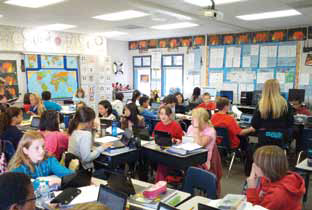
How do you decide what goes digital and what doesn’t?
Matt Akin, superintendent, Piedmont (AL) City Schools: We try to meet our curricular goals in a digital format that allows for whole-group and individualized instruction.
Fuller: We look at the resources that are available to the area that is going to be affected. If there is an abundant amount of resources that can utilize the digital content, we will always go digital first. If not, then we put a plan into place to migrate the resources to a digital resource.
Gold: It has to make complete educational sense for us in order to go digital, and we felt that in these math classes it was a great fit. We also have a 6th-grade science class that is taught in a digital environment, but in a much different manner. The science course still has a great deal of direct instruction taking place daily. Assignments, assessments, and a large amount of student collaborations are completed digitally. We don’t want to jump on any bandwagons just to do what is popular.
Klein: In most cases, our digitized delivery mechanisms for structured curriculum are provided by our textbook publishers. Ultimately, it is all acquired as part of a textbook adoption. Interestingly, a trend that began some years ago has been a reduction in the amount of physical media in favor of an increase in online content so, in a sense, the decision is being made for us. This is something of a Catch-22 as it has the potential to increase the quality and relevance of the content while reducing the mass of materials physically delivered to students. However, it simultaneously requires some form of access in terms of technology or denying access to those who lack the wherewithal to obtain it. Since most districts are unwilling or unable (usually it’s the former) to provide said access, they instead opt to deliver the content via projection systems in the room, perpetuating the familiar sage-on-the-stage, delivery-centric information dumps we are all familiar with. In addition, this new model enables a publisher to engage in the practice of ‘licensing’ content and setting expiration dates, causing content and resources to become unavailable after a prespecified period of time (unlike traditional materials). This, naturally, leads to further increased costs to schools.
A 7th-grader at Fort Leavenworth district checks her assignments on Moodle.
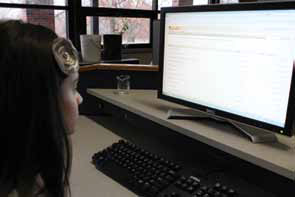
Alan Landever, director of technology; Geri Parscale, deputy superintendent, Fort Leavenworth (KS) School District: Our teachers and principals make curriculum-implementation decisions. Today’s technology simply gives them more choices. Sometimes the best choice is digital and other times it is traditional media. Our technology services department provides teachers with tools and lots of support to transition traditional curriculum into a digital format. I think that the level of support we are providing is helping teacher adoption. We have a full-time technology coordinator in each building and a curriculum integration specialist so teachers can rely on inhouse support and feel comfortable to take risks.
What percent of your digital material is from a vendor? Created by teachers? Open source?
Akin: Approximately 30% vendor, 30% open source, and 40% teacher created.
Fuller: The curriculum is mostly materials that we find on the Web or that are created by our teachers. There are very few that are open source material.
Gold: In the 7th- and 8th-grade math courses, the teachers have created online videos of themselves teaching each lesson. The students watch these videos as they progress through the assignments in each unit. They also pull in some outside sources to assist with the instruction. The daily assignments are primarily completed using a vendor (IXL Math).
Learn by doing: Teachers at Mooresville Graded School District use ANGEL.
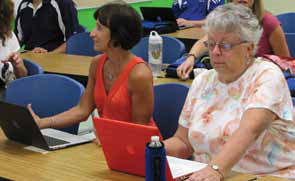
Smith: We have a combination of material we subscribe to and that teachers use for free, such as Khan Academy, Animoto, and Prezi. The cool thing is that teachers collaborate a lot so it’s easy to share resources.
How have you gotten teachers on board? How are you preparing them?
Akin: Our teachers have been on board from day one. Our MPower Piedmont initiative (piedmont.sharpschool.net/m_power_piedmont) is truly a community effort and our teachers are committed to transforming our community. I believe that is the number one reason that our initiative is successful. Our staff needs drive our PD offerings and we have early release days throughout the year that provide half-day programs for teacher collaboration.
Fuller: In 2004, we began putting electronic devices in the teacher’s classrooms that allowed them to use digital content. We always trained the teachers in a just-in-time training model. We have educational technology teachers who work with all levels of the instructional environment to use the electronic devices and digital content in all areas of the curriculum. We continually offer training to campuses, both in small and large groups, as well as district staff development on weekends and after hours.
Gold: I was fortunate enough to have two teachers who were very willing to take on this project. They have both invested a great deal of time into this initiative and they are loving it. However, people need to know that they have spent an extreme amount of time preparing for these classes. (After this first year, their preparation will be primarily focused on tweaking and improving what they have already created). A huge benefit is that they spend less time grading assignments (this now happens digitally) and more time looking at student data to determine where kids are having problems.
Landever and Parscale: We recognize that handing out devices or LMS logins won’t change much. That’s why we spend so much time on professional development. With my team and the TLA teachers providing leadership, we began a robust series of ongoing CYBERTEAMS professional development for every teacher in every building. I worked with our superintendent, the BOE, and our teachers to restructure the school day to support the Tech Tuesdays and Macs-n-Snacks Thursday professional development programs. These programs build on our PLC culture and are primarily peer-led discussions on CYBER-TEAMS, teaching pedagogy and effective use of technology in the classroom. Every teacher in the district meets for a minimum of two events per quarter, with a substitute teacher automatically provided for each teacher. Occasionally, outside subjectmatter experts facilitate the session. The do-it-yourself atmosphere has led to increased teacher confidence, willingness to try new ideas, and sharing. Some teachers even choose to attend extra programs if a topic catches their attention.
Smith: Honestly, you need to bring your teachers in before you go in this direction. They have to be thinking about changing the teaching and learning environment and how their classes will change when each student has constant Internet access. Doing that part early is important to getting buy-in. Also, they need to understand why we’re doing this. We have to meet the students where they are in a digital world. PD is huge to help teachers learn to rethink the way they’ve taught a lesson for 20 years. It’s our job to support them, provide them with ongoing instructional PD, and deliver good tech support.
What infrastructure changes do you need to make?
Akin: We made a major commitment to upgrading our network to provide fast, wireless access, and we have tripled the bandwidth of our Internet pipe in the last three years. We also provide wireless access in all outside areas of every school campus. One of the most powerful components of our initiative is that we provide home Internet access for all students. We were one of 20 districts chosen to participate in the E-rate Learning ‘On-the-Go’ pilot, which provided home Internet access for all of our students last year. Unfortunately, funding for this grant stops at the end of February. Providing true anytime, anywhere learning for low-income kids becomes very difficult when they can’t access the Internet from home.
Fuller: We are continually monitoring our infrastructure. We are upgrading our wireless network to all 5 GHz, making sure our intranet and Internet bandwidth is robust to handle the traffic demands of this ever-growing digital world.
How do you give access to the digital curriculum? LMS?
Akin: All of our teachers in grades 4-12 use the Blackboard LMS. It is amazing to see the transformation in the learning environment when all classes are taught in a blended environment.
Fuller: Our students and staff on the one-to-one campuses deliver their curriculum through our LMS system. The staff uses eduphoria!forethought for curriculum and the students use their shared folders and teacher websites to access the digital content.
Klein: We’re not big fans of the LMS because they typically represent digitizing the traditional structures of school, which is counter to the culture we want to create. We’re more about creating an SLE (social learning environment) by leveraging social tools that are available and accessible to all, such as wikis, blogs, and apps.
Landever and Parscale: We have been introducing our teachers to Moodle and they are taking to it like wildfire. Getting our curriculum into Moodle gives teachers the ability to flip classes and for students to have traditional lecture-style classes. It really opens up the potential for personalized learning, wikis, group work, and blogging. And with applications like Skype, you’re essentially diving into primary sources—you can talk directly to people all over the globe. Real life becomes the textbook. A 5th-grade teacher had her students write book reports as Amazon Book Reviews, (www.cyberteamscenter.org/21stcenturyskills/t21stcentury-book-report), causing them to rethink the way they approach their reading and writing.
Smith: We have used ANGEL [by Blackboard] from the beginning. We love it. I don’t think you can go digital without some sort of LMS. It’s easy to control the environment, share and collaborate among teachers, and provide teacher-to-student or student-tostudent communication. It has all the gradebook functionality, a parent portal, email, and all the Web 2.0 tools like blogs and wikis.
Tips from the Top
T&L spoke with Steven Engravalle, chair of the state technology committee for the New Jersey Association of School Administrators, for more tips on the digital conversion.
EVALUATE WISELY. Make sure the digital content is compatible with your district’s current—and future— tools. Does it work with laptops? Tablets? Smartphones? How does it fit into your data-management process? Does it work with your SIS and your LMS? Will the community be able to access it? The fastest way for an initiative to die is for it to not be functional for stakeholders.
DON ’T FORGET ABOUT OPEN SOURCE. There’s a myriad of useful open-source resources available and, best of all, they’re free. Two open source resources I’d recommend are HP’s Teacher Experience Exchange (h30411.www3.hp.com) and Adobe Education Exchange (edexchange.adobe.com/pages/home). In New Jersey, I’m working to create a statewide database of innovative and effective, teachercreated lesson plans and instructional resources that will be searchable by keyword, grade level, and Common Core standards.
BRING TEACHERS TO THE TABLE. Invite teachers into the conversation to help evaluate digital resources. You may need to guide them, but they have to be involved from the start if you want them to use the resources.
OFFER HAND S-ON HELP. Tech coaches are always a great idea. Whether they go into the classroom and assist teachers on the fly or just do weekly sessions, the help they provide is essential.
You can follow Engravalle on Twitter @iSchoolLeader
